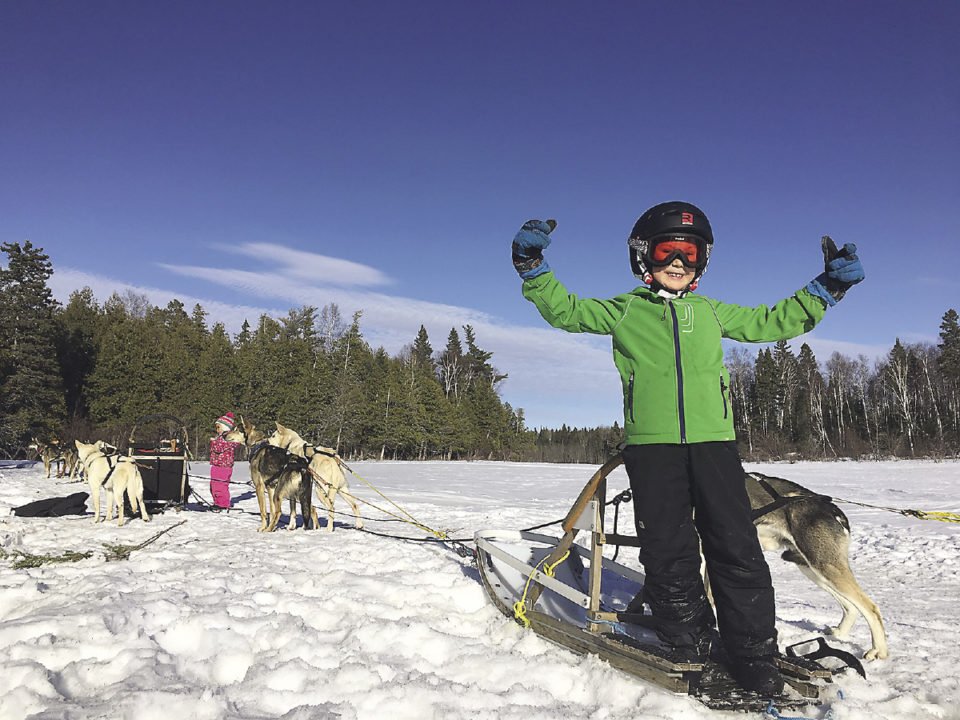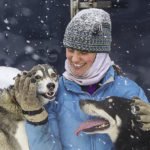Eight-year-old Tevai Terry walked up to the base of a black ash tree and carefully examined the length of its trunk for any large bumps or curves.
Satisfied that it was tall and straight enough on all sides, he stepped back as his father, Jesse Terry, felled the tree with a chainsaw.
The young boy kneeled in the snow, lightly covered with fresh sawdust, and placed a small bundle of tobacco leaves near the base of the stump. Offering tobacco, one of the four sacred medicines, is a customary practice by many Indigenous people to express gratitude following the harvest of a gift from the land, be it a moose, a medicinal herb, a fish, or a tree.
“Then, we said ‘Thank you,’” Tevai recalled. As the sun set on one of the last days of 2018, he began the process of making his first pair of Ojibwe snowshoes.
Comprised of bent hardwood frames and a pattern of intricately woven rawhide, called babiche, Ojibwe snowshoes are distinguished by pointed tips and an upturned nose. Their design makes them ideal for travel across flat terrain, much like the landscape that resembles the boy’s hometown of Sioux Lookout in northwestern Ontario.
In a region that may see the first arrival of snow as early as October, traveling efficiently during the winter months is as integral to life in the north as the season itself. So when the days become shorter and nearby lakes freeze over, there is a good chance that Tevai and his five-year-old sister, Miali, are running sled dogs, going winter camping, and setting hare snares with their family.
Much of that requires trekking through the bush, or simply using snowshoes to pack down the surface for a tent. But when his store-bought snowshoes weren’t performing so well, Tevai decided to make his own, and turned to the technical ingenuity of his people.
“The homemade snowshoes are more natural and special; the plastic ones…they just kind of make me sink,” he told me during a telephone call a couple weeks after he hauled the tree out of the bush with his dad. “I wanted to try something new, and I want to do it the way that Anishinaabe people do it, or the Ojibwe people make snowshoes. Because I am Anishinaabe.”
After Tevai and Jesse brought home the log, they quartered it and used a hatchet to square off the sides. Once the pieces are further refined with a draw knife, they will be put into a snowshoe form and left to dry.
A Family Affair
“Then we use the rawhide,” explained Tevai. “The babiche, for weaving.”
Luckily, he didn’t have to look far for a source of this material. Tevai’s auntie Kanina, who lives nearby, prepared rawhide from a white-tailed deer that will be cut into strips and used for snowshoe lacing.
“We chose deer instead of the moose for these snowshoes because it is lighter and thinner and easier for him to weave,” explained his dad. “[We’ll use] the thicker strips for the middle of the shoe and thinner strips for the ends.”
Jesse, 35, became familiar with snowshoe-making in his late 20s while he was running outdoor skills programs with youth in the nearby community of Lac Seul.
“I grew up working with wood and carving with wood, but I had never made a pair of snowshoes before I was leading these programs,” he recalled. “All the while I had an uncle, my mom’s older brother, Paddy Kenny, building snowshoes all his life.”
As the course went on, Jesse brought his uncle in for counsel and guidance.
Two weeks later, participants each went home with a finished pair of handmade snowshoes.
“It was all kind of crucial to have the assistance of Paddy Kenny. And it was really neat to see how proud some of these guys were. It was very satisfying for them, and you could tell that they felt good about what they did. I think that feeling good about that is one step toward feeling good about who they are as Anishinaabe people,” said Jesse, who’s planning for him and Tevai to spend time with his uncle when the wooden frames are ready for weaving.
“I think I’ll need a refresher. It’ll be a great chance to hang out with my Uncle Paddy, the same man who taught me about making tikinagans (cradleboards) when I first became a father.”
Cultural Identity
After speaking with the father and son pair, it became clear that for them, the process of making snowshoes carries as much value as the final product.
“It just makes me feel really proud as a father to hear that he’s so interested in learning these skills that I feel, for me personally, are really important,” said Jesse. “Tevai talked about the Anishinaabe way and how the things that we’re doing are part of our culture as Anishinaabe people. When we do these things, we are helping to keep parts of our culture and traditions alive…To pass them onto my son and to my daughter, it just feels good, it feels right, it feels like what I need to be doing, and it feels like what I should be doing.”
Tevai predicts he’ll be able to use his handmade snowshoes for a few winters before he’ll outgrow them and need a bigger pair. Have you thought about what you’d like to make for your next project? I asked him. Without hesitation, he replied, “I want to make a birch bark canoe with my dad when I’m a little older.” By the sound of his conviction, he will be going places.




